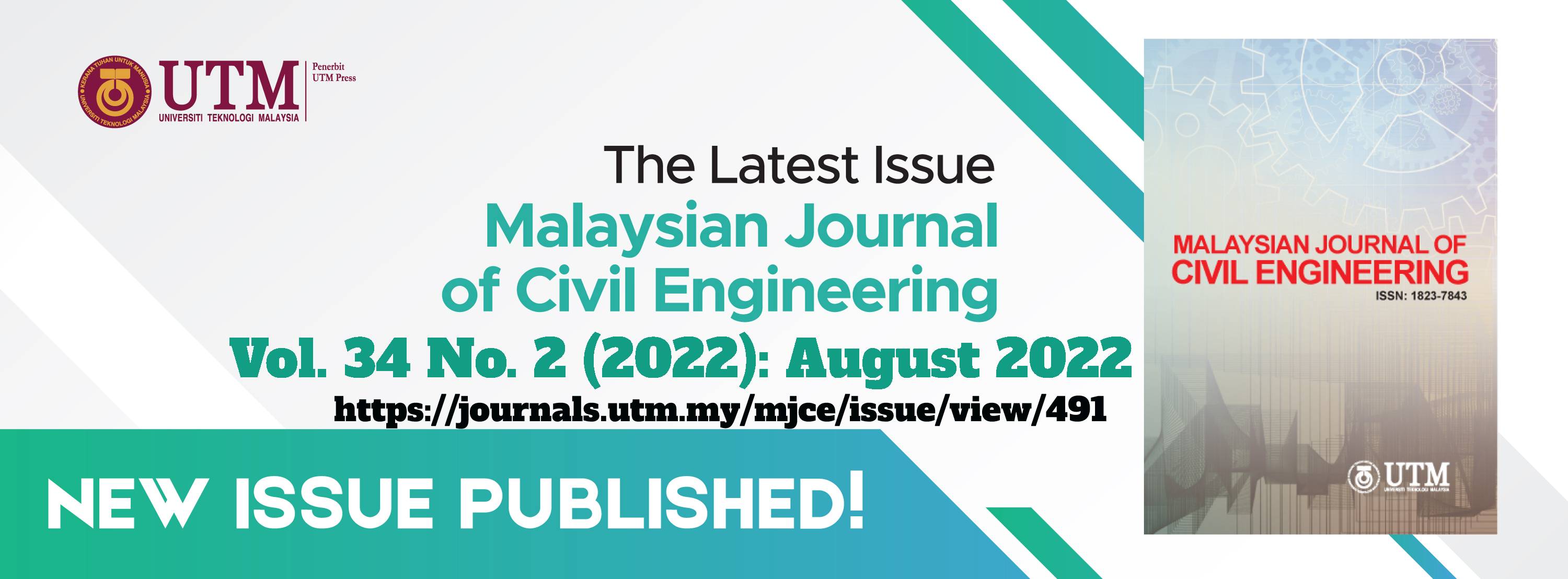FACTORS AFFECTING MIX DESIGN OF CONCRETE
DOI:
https://doi.org/10.11113/mjce.v34.18311Keywords:
ACI method, British method, Concrete, Factors, Mix Design, ACI Standard, British Standard, Concrete, Aggregate, Mix Design.Abstract
Concrete is a low-maintenance composite material that is primarily composed of cementitious material, water and gravel. It is often used construction material not only in Bangladesh but also across the world. The design of the concrete mix is a critical determinant of the qualities of the concrete. The fundamental ideas and comparative research of certain prominent concrete mix design methods from a qualitative perspective are presented in this work. Two types of concrete mix designs are used which are ACI 211.1-91 (2002) Standard and British Standard (1997) in this paper. Several factors have been determined in this study to choose between the ACI and British Standard. These approaches rely heavily on graphs, tables and bar charts with arbitrary values. The nominal maximum size of coarse aggregate, water to cement ratio (w/c), slump value and the % passing of fine aggregates are used here to change the amount of materials. Differentiating between these strategies allows for a better understanding of the impacts of variables. The ACI and British Standard have been used to compare how the w/c, fine aggregate to cement ratio (FA/C), total aggregate to cement ratio (TA/C) and fine aggregate to total aggregate ratio (FA/TA) are different for various strengths. The following study is expected to pave the path of concrete performance via extensive research on different suggested design factors.
References
Bint Ashraf, W. 2012. Concrete Mix Design Procedure Using Locally Available Materials. M. Sc. Thesis, Bangladesh University of Science & Technology. [1-2, 125]
Shetty, M. S., & Jain, A. K. 2019. Concrete Technology (Theory and Practice), 8e. S. Chand Publishing, 66.
Mishra, S. P. 2012. Comparison of IS, BS and ACI Methods of concrete mix design and proposing function equations based design. Research and Development (IJCSEIERD), 2(1): 20-56.
Santhosh R., & Dr. Shivananda P. [2017]. A review of Concrete Mix Designs. International Journal for Research in Applied Science & Engineering Technology (IJRASET) 5(XI): page (586-590) ISSN: 2321-9653; http:// DOI:10.22214/ijraset.2017.11091
Chhachhia, A. 2021. Concrete Mix Design by IS, ACI and BS Methods: A Comparative Analysis. Journal of Building Material Science, 2(1). Page (30-33); http://dx.doi.org/10.30564/jbms.v2i1.2636
Yurdakul, E. 2010. Optimizing concrete mixtures with minimum cement content for performance and sustainability. Master of Science, Iowa State University.
Ahmed, M., Islam, S., Nazar, S., & Khan, R. A. 2016. A comparative study of popular concrete mix design methods from qualitative and cost-effective point of view for extreme environment. Arabian Journal For Science And Engineering, 41(4): 1403-1412. http://DOI:10.1007/s13369-015-1946-9
Okah, J. C., & Amos Elekima N.J. [2018]. Effect of Aggregate/Cement and Water/Cement Ratios on Concrete Workability. International Journal of Geography and Environmental Management ISSN 2504-8821; Vol. 4. Port Harcourt Polytechnic.
Lin, W. T. 2020. Effects of sand/aggregate ratio on strength, durability, and microstructure of self-compacting concrete. Construction and Building Materials, 242: 118046.
Uddin, M. T., Harun, M. Z. B., Joy, J. A., & Ahmed, M. A 2020. Effect of sand-to-aggregate volume ratio on mechanical properties of concrete. IABSE-JSCE Joint Conference on Advances in Bridge Engineering-IV, Dhaka, Bangladesh; ISBN: 978-984-34-8313-3.
Dixon, D. E., Prestrera, J. R., Burg, G. R., Chairman, S. A., Abdun-Nur, E. A., Barton, S. G., ... & Lee, S. H. 1991. Standard Practice for Selecting Proportions for Normal, Heavyweight, and Mass Concrete (ACI 211.1-91).
Neville, A. M., & Brooks, J. J. 1987. Concrete technology (pp. 242-246). England: Longman Scientific & Technical [15,25]
Berwal, M. P., & Goel, R. 2017. An Overview on Utilization of Industrial Waste in Civil Ezgineering. International Journal for Research in Applied Science & Engineering Technology (IJRASET) 5(X): Page(63-67) ISSN: 2321-9653; http://dx.doi.org/10.22214/ijraset.2017.10010
Mim, N. Z., Nira, K. R., Tahmid, A., & Chowdhury, S. R. 2021. State of The Art Review of Bond Properties of Reinforcing Bar Embedded in Brick Aggregate Concrete. Journal of Structural Engineering, its Applications and Analysis, 4(2): 1-14
Mahmud, M. S., Reza, A., Sutradhar, A., Tahmid, A., & Chowdhury, S. R. 2022. A Study on the Behavior of Standard and Non-standard Sized Cores Made of Brick and Stone Chips, 5(2). Page (1-13). https://doi.org/10.5281/zenodo.6467384
















